Healthcare Case Study: Analyzing Patient Care and ICT Implementation
VerifiedAdded on 2021/04/21
|5
|1224
|245
Report
AI Summary
This report analyzes a healthcare case study, highlighting issues in the systematic flow of healthcare information. The case study reveals inefficiencies in patient care, including inadequate diagnostic procedures, lack of family history assessment, and inconvenient referral processes. As a health service manager, the report proposes the implementation of ICT solutions, specifically electronic health records (EHRs), improved communication tools like telephones and email, to streamline patient journeys. The redesign aims to improve data capture, storage, and sharing, leading to time savings, reduced costs, and enhanced patient accessibility. The report acknowledges potential obstacles, such as integration challenges, technical limitations, financial constraints, and data privacy concerns. Ultimately, the report emphasizes the potential of ICT to transform healthcare delivery and patient outcomes.
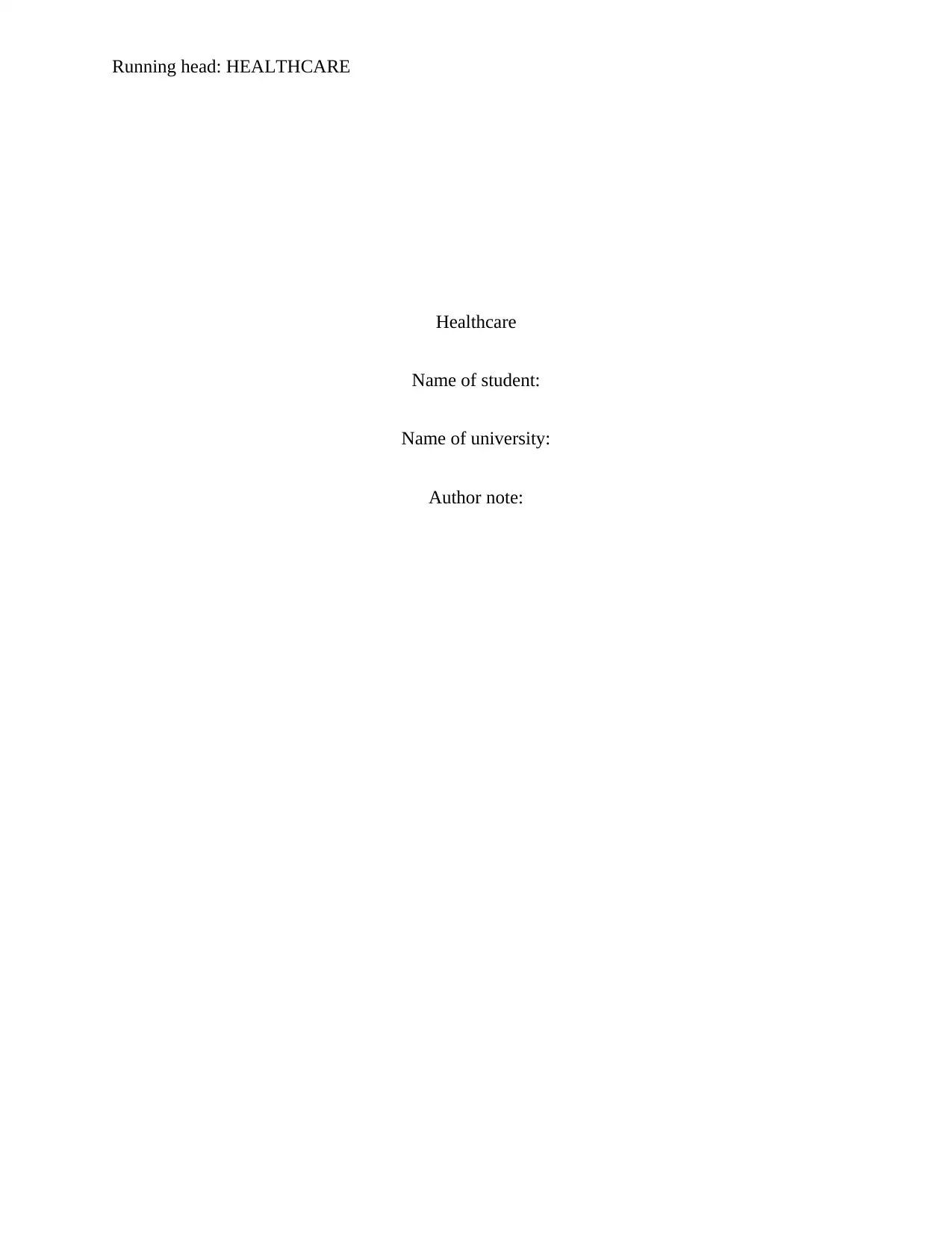
Running head: HEALTHCARE
Healthcare
Name of student:
Name of university:
Author note:
Healthcare
Name of student:
Name of university:
Author note:
Paraphrase This Document
Need a fresh take? Get an instant paraphrase of this document with our AI Paraphraser
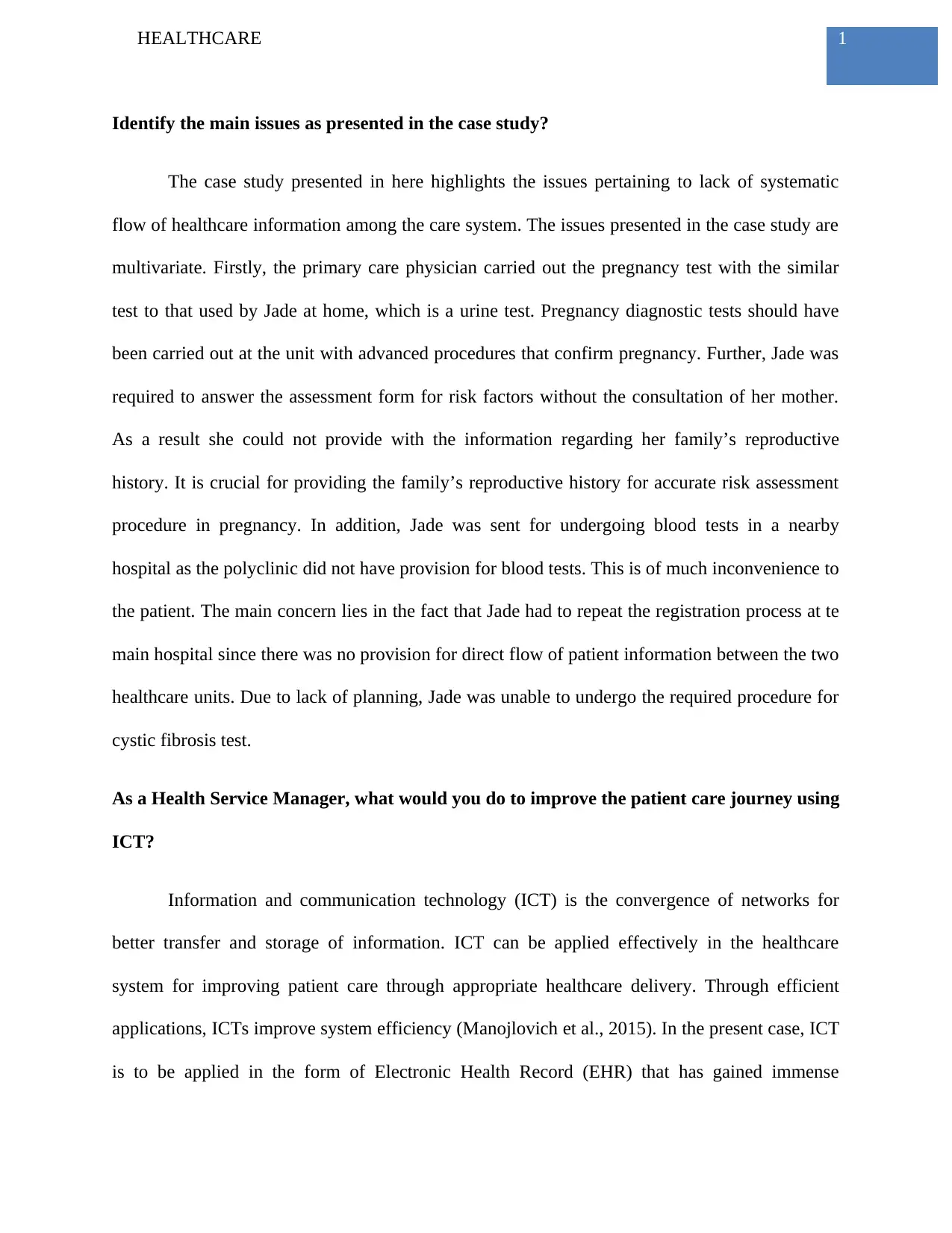
1HEALTHCARE
Identify the main issues as presented in the case study?
The case study presented in here highlights the issues pertaining to lack of systematic
flow of healthcare information among the care system. The issues presented in the case study are
multivariate. Firstly, the primary care physician carried out the pregnancy test with the similar
test to that used by Jade at home, which is a urine test. Pregnancy diagnostic tests should have
been carried out at the unit with advanced procedures that confirm pregnancy. Further, Jade was
required to answer the assessment form for risk factors without the consultation of her mother.
As a result she could not provide with the information regarding her family’s reproductive
history. It is crucial for providing the family’s reproductive history for accurate risk assessment
procedure in pregnancy. In addition, Jade was sent for undergoing blood tests in a nearby
hospital as the polyclinic did not have provision for blood tests. This is of much inconvenience to
the patient. The main concern lies in the fact that Jade had to repeat the registration process at te
main hospital since there was no provision for direct flow of patient information between the two
healthcare units. Due to lack of planning, Jade was unable to undergo the required procedure for
cystic fibrosis test.
As a Health Service Manager, what would you do to improve the patient care journey using
ICT?
Information and communication technology (ICT) is the convergence of networks for
better transfer and storage of information. ICT can be applied effectively in the healthcare
system for improving patient care through appropriate healthcare delivery. Through efficient
applications, ICTs improve system efficiency (Manojlovich et al., 2015). In the present case, ICT
is to be applied in the form of Electronic Health Record (EHR) that has gained immense
Identify the main issues as presented in the case study?
The case study presented in here highlights the issues pertaining to lack of systematic
flow of healthcare information among the care system. The issues presented in the case study are
multivariate. Firstly, the primary care physician carried out the pregnancy test with the similar
test to that used by Jade at home, which is a urine test. Pregnancy diagnostic tests should have
been carried out at the unit with advanced procedures that confirm pregnancy. Further, Jade was
required to answer the assessment form for risk factors without the consultation of her mother.
As a result she could not provide with the information regarding her family’s reproductive
history. It is crucial for providing the family’s reproductive history for accurate risk assessment
procedure in pregnancy. In addition, Jade was sent for undergoing blood tests in a nearby
hospital as the polyclinic did not have provision for blood tests. This is of much inconvenience to
the patient. The main concern lies in the fact that Jade had to repeat the registration process at te
main hospital since there was no provision for direct flow of patient information between the two
healthcare units. Due to lack of planning, Jade was unable to undergo the required procedure for
cystic fibrosis test.
As a Health Service Manager, what would you do to improve the patient care journey using
ICT?
Information and communication technology (ICT) is the convergence of networks for
better transfer and storage of information. ICT can be applied effectively in the healthcare
system for improving patient care through appropriate healthcare delivery. Through efficient
applications, ICTs improve system efficiency (Manojlovich et al., 2015). In the present case, ICT
is to be applied in the form of Electronic Health Record (EHR) that has gained immense
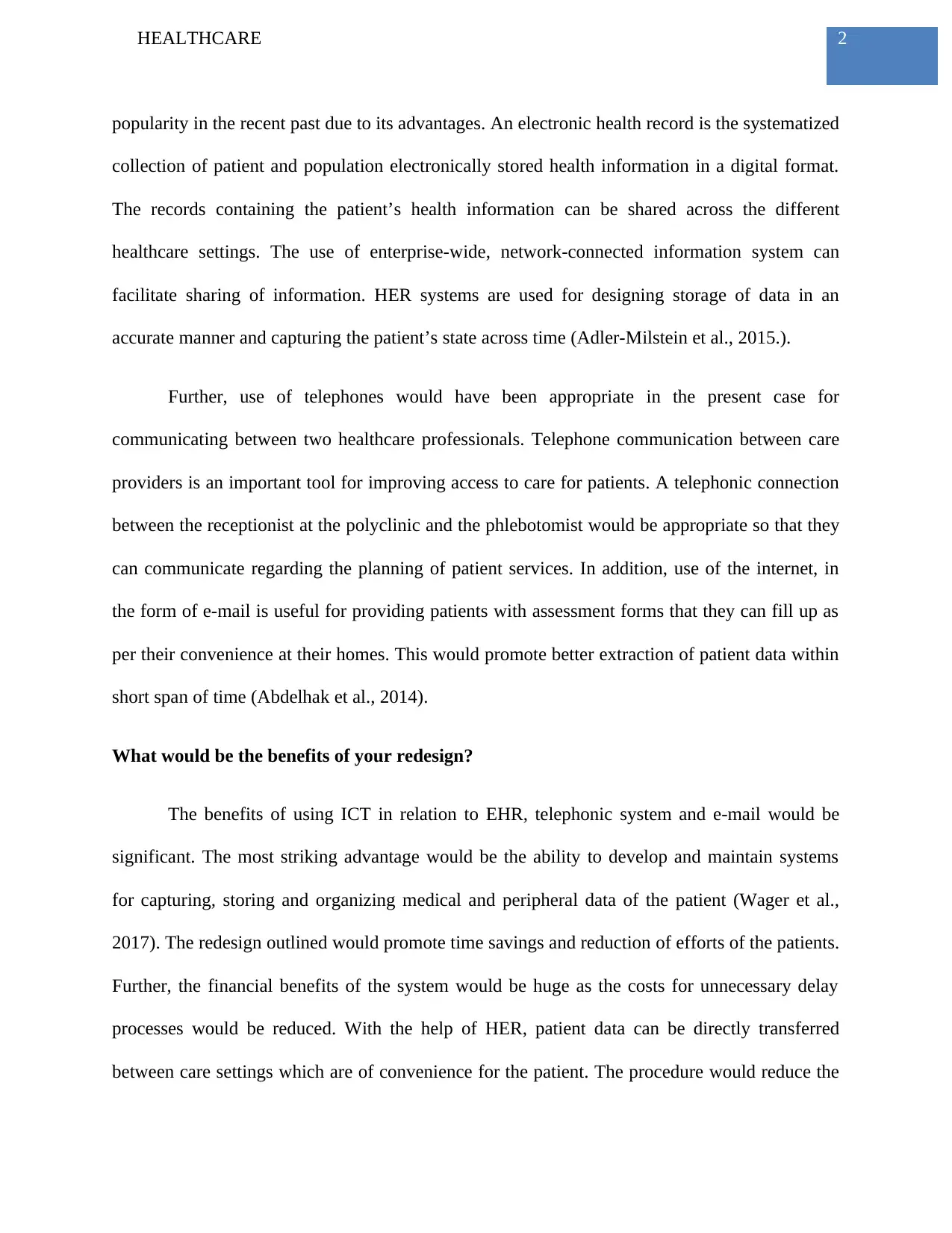
2HEALTHCARE
popularity in the recent past due to its advantages. An electronic health record is the systematized
collection of patient and population electronically stored health information in a digital format.
The records containing the patient’s health information can be shared across the different
healthcare settings. The use of enterprise-wide, network-connected information system can
facilitate sharing of information. HER systems are used for designing storage of data in an
accurate manner and capturing the patient’s state across time (Adler-Milstein et al., 2015.).
Further, use of telephones would have been appropriate in the present case for
communicating between two healthcare professionals. Telephone communication between care
providers is an important tool for improving access to care for patients. A telephonic connection
between the receptionist at the polyclinic and the phlebotomist would be appropriate so that they
can communicate regarding the planning of patient services. In addition, use of the internet, in
the form of e-mail is useful for providing patients with assessment forms that they can fill up as
per their convenience at their homes. This would promote better extraction of patient data within
short span of time (Abdelhak et al., 2014).
What would be the benefits of your redesign?
The benefits of using ICT in relation to EHR, telephonic system and e-mail would be
significant. The most striking advantage would be the ability to develop and maintain systems
for capturing, storing and organizing medical and peripheral data of the patient (Wager et al.,
2017). The redesign outlined would promote time savings and reduction of efforts of the patients.
Further, the financial benefits of the system would be huge as the costs for unnecessary delay
processes would be reduced. With the help of HER, patient data can be directly transferred
between care settings which are of convenience for the patient. The procedure would reduce the
popularity in the recent past due to its advantages. An electronic health record is the systematized
collection of patient and population electronically stored health information in a digital format.
The records containing the patient’s health information can be shared across the different
healthcare settings. The use of enterprise-wide, network-connected information system can
facilitate sharing of information. HER systems are used for designing storage of data in an
accurate manner and capturing the patient’s state across time (Adler-Milstein et al., 2015.).
Further, use of telephones would have been appropriate in the present case for
communicating between two healthcare professionals. Telephone communication between care
providers is an important tool for improving access to care for patients. A telephonic connection
between the receptionist at the polyclinic and the phlebotomist would be appropriate so that they
can communicate regarding the planning of patient services. In addition, use of the internet, in
the form of e-mail is useful for providing patients with assessment forms that they can fill up as
per their convenience at their homes. This would promote better extraction of patient data within
short span of time (Abdelhak et al., 2014).
What would be the benefits of your redesign?
The benefits of using ICT in relation to EHR, telephonic system and e-mail would be
significant. The most striking advantage would be the ability to develop and maintain systems
for capturing, storing and organizing medical and peripheral data of the patient (Wager et al.,
2017). The redesign outlined would promote time savings and reduction of efforts of the patients.
Further, the financial benefits of the system would be huge as the costs for unnecessary delay
processes would be reduced. With the help of HER, patient data can be directly transferred
between care settings which are of convenience for the patient. The procedure would reduce the
⊘ This is a preview!⊘
Do you want full access?
Subscribe today to unlock all pages.

Trusted by 1+ million students worldwide
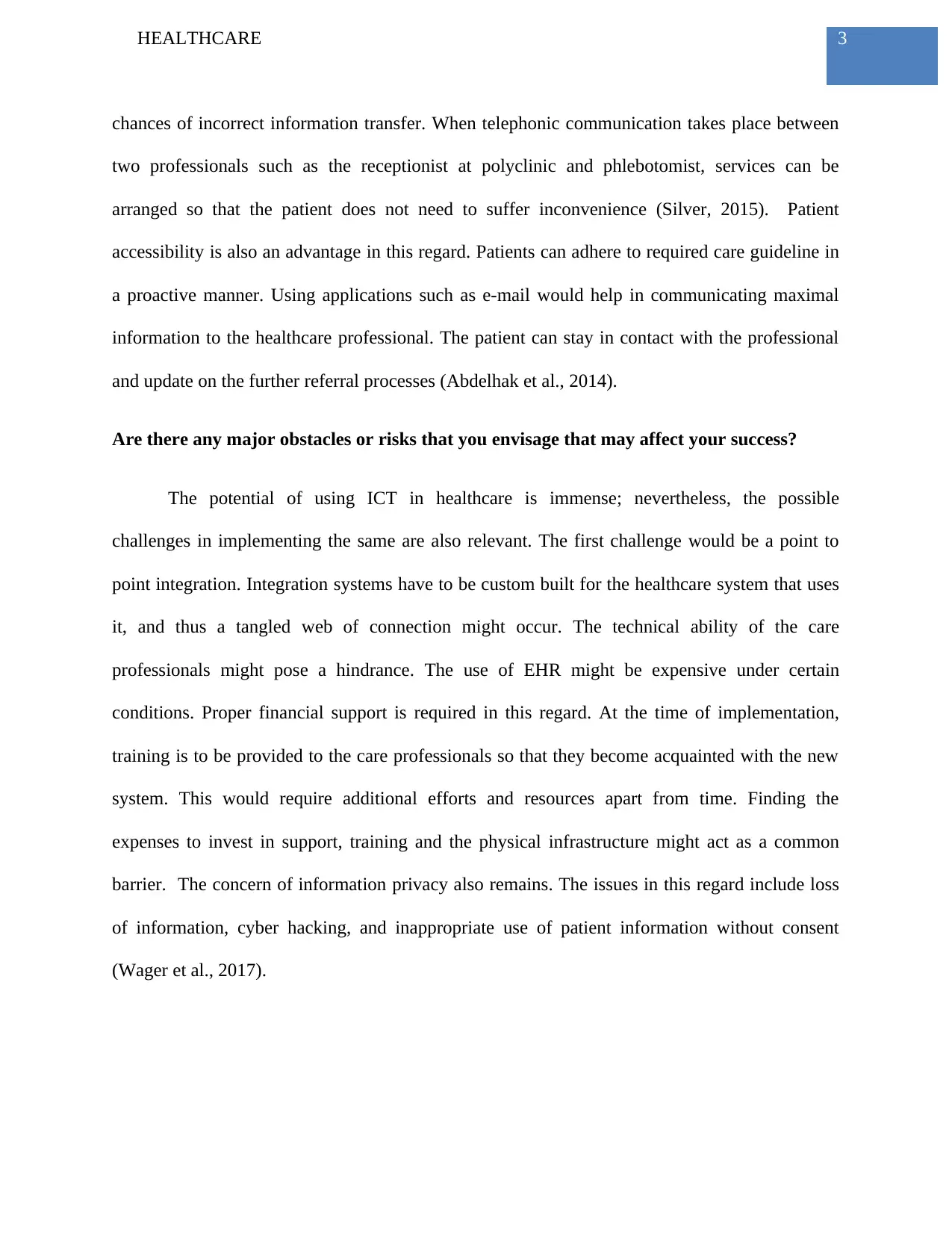
3HEALTHCARE
chances of incorrect information transfer. When telephonic communication takes place between
two professionals such as the receptionist at polyclinic and phlebotomist, services can be
arranged so that the patient does not need to suffer inconvenience (Silver, 2015). Patient
accessibility is also an advantage in this regard. Patients can adhere to required care guideline in
a proactive manner. Using applications such as e-mail would help in communicating maximal
information to the healthcare professional. The patient can stay in contact with the professional
and update on the further referral processes (Abdelhak et al., 2014).
Are there any major obstacles or risks that you envisage that may affect your success?
The potential of using ICT in healthcare is immense; nevertheless, the possible
challenges in implementing the same are also relevant. The first challenge would be a point to
point integration. Integration systems have to be custom built for the healthcare system that uses
it, and thus a tangled web of connection might occur. The technical ability of the care
professionals might pose a hindrance. The use of EHR might be expensive under certain
conditions. Proper financial support is required in this regard. At the time of implementation,
training is to be provided to the care professionals so that they become acquainted with the new
system. This would require additional efforts and resources apart from time. Finding the
expenses to invest in support, training and the physical infrastructure might act as a common
barrier. The concern of information privacy also remains. The issues in this regard include loss
of information, cyber hacking, and inappropriate use of patient information without consent
(Wager et al., 2017).
chances of incorrect information transfer. When telephonic communication takes place between
two professionals such as the receptionist at polyclinic and phlebotomist, services can be
arranged so that the patient does not need to suffer inconvenience (Silver, 2015). Patient
accessibility is also an advantage in this regard. Patients can adhere to required care guideline in
a proactive manner. Using applications such as e-mail would help in communicating maximal
information to the healthcare professional. The patient can stay in contact with the professional
and update on the further referral processes (Abdelhak et al., 2014).
Are there any major obstacles or risks that you envisage that may affect your success?
The potential of using ICT in healthcare is immense; nevertheless, the possible
challenges in implementing the same are also relevant. The first challenge would be a point to
point integration. Integration systems have to be custom built for the healthcare system that uses
it, and thus a tangled web of connection might occur. The technical ability of the care
professionals might pose a hindrance. The use of EHR might be expensive under certain
conditions. Proper financial support is required in this regard. At the time of implementation,
training is to be provided to the care professionals so that they become acquainted with the new
system. This would require additional efforts and resources apart from time. Finding the
expenses to invest in support, training and the physical infrastructure might act as a common
barrier. The concern of information privacy also remains. The issues in this regard include loss
of information, cyber hacking, and inappropriate use of patient information without consent
(Wager et al., 2017).
Paraphrase This Document
Need a fresh take? Get an instant paraphrase of this document with our AI Paraphraser
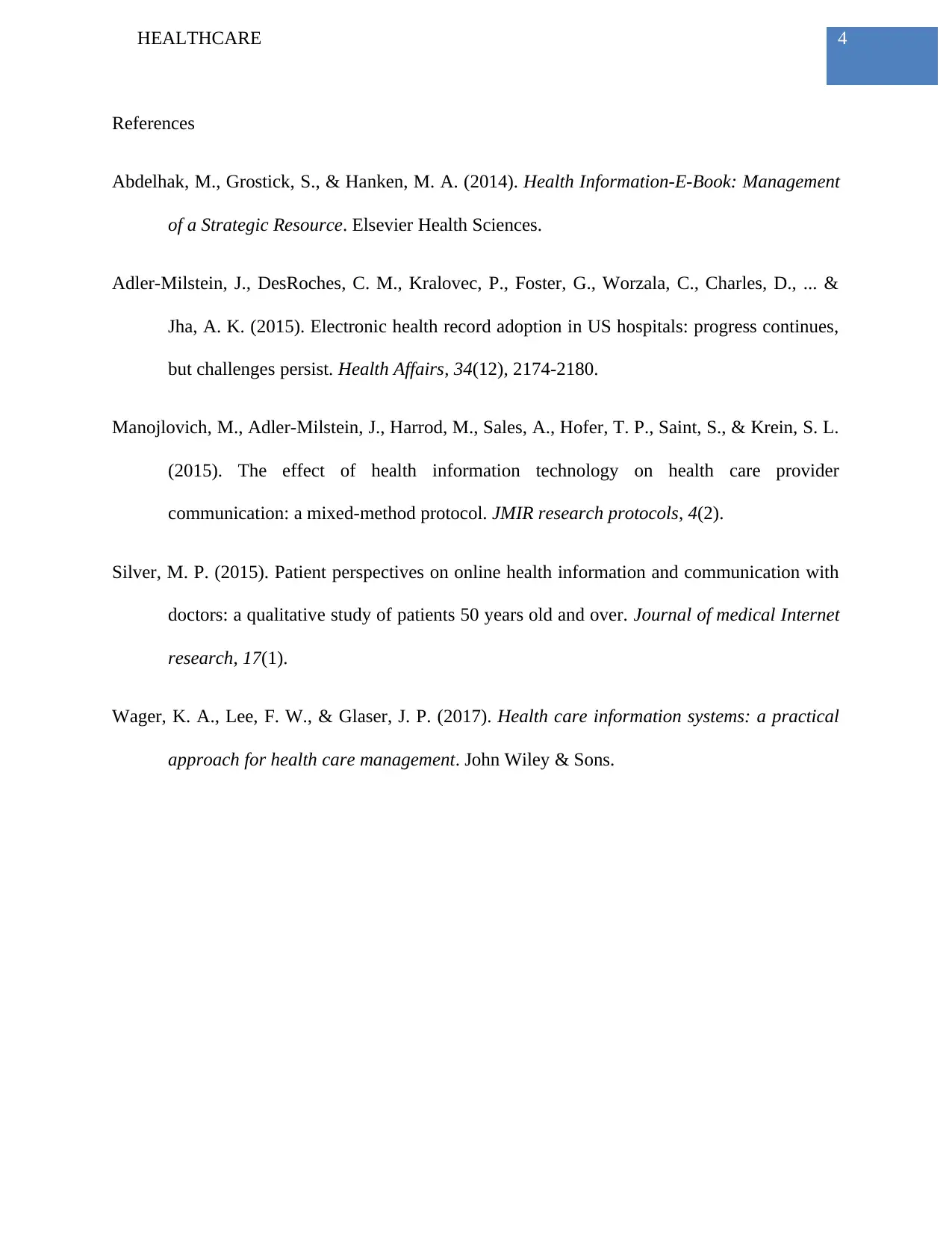
4HEALTHCARE
References
Abdelhak, M., Grostick, S., & Hanken, M. A. (2014). Health Information-E-Book: Management
of a Strategic Resource. Elsevier Health Sciences.
Adler-Milstein, J., DesRoches, C. M., Kralovec, P., Foster, G., Worzala, C., Charles, D., ... &
Jha, A. K. (2015). Electronic health record adoption in US hospitals: progress continues,
but challenges persist. Health Affairs, 34(12), 2174-2180.
Manojlovich, M., Adler-Milstein, J., Harrod, M., Sales, A., Hofer, T. P., Saint, S., & Krein, S. L.
(2015). The effect of health information technology on health care provider
communication: a mixed-method protocol. JMIR research protocols, 4(2).
Silver, M. P. (2015). Patient perspectives on online health information and communication with
doctors: a qualitative study of patients 50 years old and over. Journal of medical Internet
research, 17(1).
Wager, K. A., Lee, F. W., & Glaser, J. P. (2017). Health care information systems: a practical
approach for health care management. John Wiley & Sons.
References
Abdelhak, M., Grostick, S., & Hanken, M. A. (2014). Health Information-E-Book: Management
of a Strategic Resource. Elsevier Health Sciences.
Adler-Milstein, J., DesRoches, C. M., Kralovec, P., Foster, G., Worzala, C., Charles, D., ... &
Jha, A. K. (2015). Electronic health record adoption in US hospitals: progress continues,
but challenges persist. Health Affairs, 34(12), 2174-2180.
Manojlovich, M., Adler-Milstein, J., Harrod, M., Sales, A., Hofer, T. P., Saint, S., & Krein, S. L.
(2015). The effect of health information technology on health care provider
communication: a mixed-method protocol. JMIR research protocols, 4(2).
Silver, M. P. (2015). Patient perspectives on online health information and communication with
doctors: a qualitative study of patients 50 years old and over. Journal of medical Internet
research, 17(1).
Wager, K. A., Lee, F. W., & Glaser, J. P. (2017). Health care information systems: a practical
approach for health care management. John Wiley & Sons.
1 out of 5
Related Documents
Your All-in-One AI-Powered Toolkit for Academic Success.
+13062052269
info@desklib.com
Available 24*7 on WhatsApp / Email
![[object Object]](/_next/static/media/star-bottom.7253800d.svg)
Unlock your academic potential
Copyright © 2020–2025 A2Z Services. All Rights Reserved. Developed and managed by ZUCOL.





